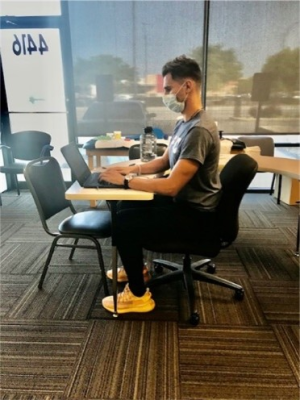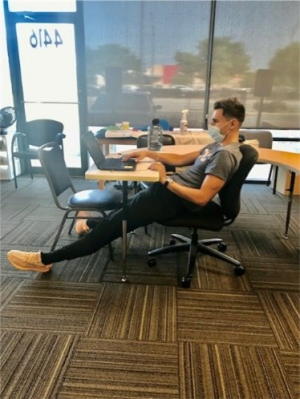When I complete a hand therapy evaluation with someone who has upper body pain and works or learns on their device, I ask several questions. How many hours a day are you using your device? How many hours at one time before taking a break are you using your device? What is your workspace and setup like? What things do you do before/after time on your device? These questions tap into a few variables that can be controlled to combat typical hand, wrist, and shoulder pain symptoms that many students and desk workers fall victim to.
The following recommendations are proactive ways to prevent upper body pain to learn and work more effectively:
- Less is more: One should try and spread out the volume of time required to be on said devices throughout the day. If possible, break up the use of technology into smaller chunks of time compared to grouping all e-learning time at once.
- Take Breaks: Deadlines and assignments require hard work and persistence. I recommend that you set timers and schedule breaks to minimize fatigue and poor sitting postures that place our wrists and shoulders in compromised positions.. Besides breaking, it is also recommended to move our bodies in ways opposite to how we sit and work. For example, stand up, pull your shoulders back, reach forward/upwards, and extend your wrists and fingers to the sky. Doing this every hour can not only serve as a reminder to ourselves about good body mechanics but also improve circulation and stretch tight muscles and tendons to minimize pain.
- Set up is critical: To avoid pain while using our devices, it is critical to think about ergonomics, or the way our body’s design interacts with the design of the tools we use. Start by placing your screen at eye level, either by raising your desk space or your device itself. Sit with your back and shoulders supported by a backrest with your feet flat on the ground. Support your forearms/wrists on a pad or soft surface edge to minimize contact force pressure. Lastly, ensure your wrist is not positioned too far flexed or extended. These simple adjustments help our body’s design interact with our environment and stay pain-free.
Good v. Poor Sitting Posture and set-up


- Have a balance: If the demands of school and work require hours of effort while using a device, be kind to yourself and schedule extra-curricular activities that minimize the use of technology. Going from school desks and tablets to armchairs and cell phones only adds environmental stress to the body, contributing to upper body pain. Consider what you enjoy that is not high-tech and work those activities into your daily routine to give your body a chance to recover from tablet use throughout the day.
There is nothing fun about upper body pain derived from poor ergonomics and excessive time on technology, but there is nothing technical about the ways to improve symptoms. Being persistent and proactive with how and when we use our devices is the most important consideration one can make. Furthermore, assisting and educating younger students for success will be most helpful as digital learning continues to increase.
When in Doubt, See a Healthcare Professional
Aches and pains may not simply go away on their own. If you notice symptoms that will not go away (or that get worse), visit your nearest Athletico Physical Therapy to get your symptoms checked out. Your clinician can develop a plan-of-care individually tailored to your needs, or he or she can refer you out to the appropriate medical professional. Get started by scheduling your Free Assessment. Free assessments are available in-clinic or virtually through our Telehealth platform.
*Per federal guidelines, beneficiaries of plans such as Medicare, Medicaid, Tricare, VHA and other federally funded plans are not eligible for free assessments.
The Athletico blog is an educational resource written by Athletico employees. Athletico bloggers are licensed professionals who abide by the code of ethics outlined by their respective professional associations. The content published in blog posts represents the opinion of the individual author based on their expertise and experience. The content provided in this blog is for informational purposes only, does not constitute medical advice and should not be relied on for making personal health decisions.
About the Author:
Erik J. Krol is a Hand Therapist/Occupational Therapist, father of two, runner, and former college athlete. Erik uses his background education in kinesiology and professional training in hand therapy to provide recommendations on preventing injuries during daily roles and routines. Follow Erik's work and interests in remaining healthy and, more importantly, functional to achieve family, work, and personal goals while combating the environmental and aging challenges.

 width="900"
height="356"
>
width="900"
height="356"
>
